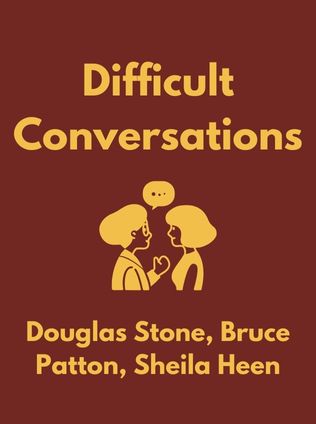
Difficult Conversations
How to Discuss What Matters Most
By Douglas Stone, Bruce Patton, Sheila Heen
Published 04/1999
About the Author
"Difficult Conversations: How to Discuss What Matters Most" is authored by Douglas Stone, Bruce Patton, and Sheila Heen, three prominent figures in the field of negotiation and conflict resolution. All three are members of the Harvard Negotiation Project, where they have conducted extensive research and taught negotiation strategies for decades. Their expertise is deeply rooted in the practical application of negotiation theory, and they have collectively authored and co-authored several influential books on the subject, including the best-seller "Getting to Yes." This book reflects their combined knowledge and experience in helping individuals navigate some of the most challenging conversations they will encounter, whether in professional settings or personal relationships.
Douglas Stone is a lecturer on law at Harvard Law School and has taught negotiation and conflict resolution for over 20 years. His work focuses on the human dynamics that influence conversations, especially those that are emotionally charged. Bruce Patton, a co-founder of the Harvard Negotiation Project, has been at the forefront of negotiation and mediation theory, contributing significantly to the development of the field. Sheila Heen, also a lecturer on law at Harvard, specializes in managing difficult conversations and giving and receiving feedback. Her insights into how to handle the emotions and identities involved in difficult discussions have been instrumental in shaping the strategies presented in this book.
Together, these authors bring a wealth of knowledge and practical insight to the topic of difficult conversations. They have worked with organizations, governments, and individuals worldwide to help them engage in more productive and less adversarial dialogues. Their book is a guide to understanding the underlying dynamics of difficult conversations and provides actionable strategies for handling them more effectively.
Main Idea
"Difficult Conversations" explores the dynamics that make certain conversations particularly challenging and offers a framework for navigating these discussions more effectively. The central premise is that difficult conversations are difficult not because of the subject matter alone but because of how we approach them. The authors argue that most people enter difficult conversations with a mindset focused on being right, protecting their identity, or avoiding conflict, which often leads to poor outcomes. The book presents a new approach, encouraging readers to embrace curiosity, empathy, and a willingness to explore the other person’s perspective. By understanding and addressing the underlying issues—such as emotions, identity, and differing perceptions—we can transform difficult conversations into opportunities for connection, learning, and problem-solving.
The authors introduce three key types of conversations that are embedded in every difficult conversation: the What Happened Conversation, the Feelings Conversation, and the Identity Conversation. These three aspects interact to create the complexity and challenge of difficult conversations. The book offers strategies for recognizing and navigating these layers, helping readers to approach difficult conversations with greater awareness and skill.
Table of Contents
- Introduction to Difficult Conversations
- The Three Conversations
- The What Happened Conversation
- The Feelings Conversation
- The Identity Conversation
- Guidelines for Effective Difficult Conversations
- Practical Applications and Examples
Introduction to Difficult Conversations
Difficult conversations are an integral part of life, occurring in professional settings, personal relationships, and everyday interactions. These conversations are characterized by high emotional stakes, conflicting viewpoints, and often, a fear of the consequences. According to the authors, the true challenge of difficult conversations lies not in the topics themselves but in the way we approach them. Typically, people enter these conversations with a desire to assert their point of view, protect their self-image, or avoid conflict altogether. This mindset often leads to conversations that are unproductive or even damaging.
The authors argue that the key to handling difficult conversations more effectively is to change our approach. Instead of focusing on winning the argument or defending our position, we should adopt a mindset of curiosity and empathy. This involves being genuinely interested in the other person’s perspective and being open to the possibility that our own assumptions and beliefs might need to be reconsidered. By shifting our approach, we can create a more constructive dialogue that opens the door to understanding and resolution.
The book emphasizes that difficult conversations are not just about the content of the discussion but also about the underlying dynamics at play. These include the emotions involved, the impact on our identity, and the different perceptions of the situation. The authors introduce the concept of "The Three Conversations," which they believe are at the heart of every difficult conversation. Understanding these conversations is the first step in managing difficult discussions more effectively.
Sign up for FREE and get access to 1,400+ books summaries.
You May Also Like
The Subtle Art of Not Giving a F*ck
A Counterintuitive Approach to Living a Good Life
By Mark MansonRich Dad Poor Dad
What the Rich Teach Their Kids About Money - That the Poor and Middle Class Do Not!
By Robert T. KiyosakiHow To Win Friends and Influence People
The All-Time Classic Manual Of People Skills
By Dale CarnegieFreakonomics
A Rogue Economist Explores the Hidden Side of Everything
By Steven D. Levitt and Stephen J. Dubner



















